Tag: Global Connections
Information and society – Reflection on INF506 Module 2
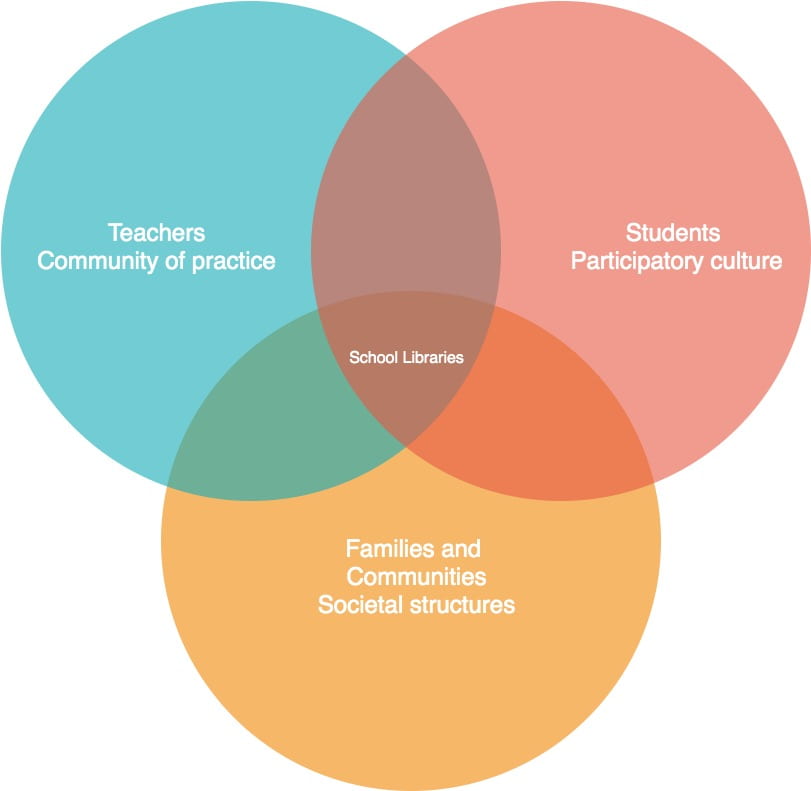
OLJ Task 2: The influence of technology on society or OLJ Task 3: Reflections on the impact of change
To be or not to be (active on social media) is no longer the question
 If we want ‘customer-driven, socially rich, and collaborative model of service and content delivery’ (module 2) then we must stop asking ‘why’ or ‘when’ and start asking ‘how.’
If we want ‘customer-driven, socially rich, and collaborative model of service and content delivery’ (module 2) then we must stop asking ‘why’ or ‘when’ and start asking ‘how.’
Why do we expect teachers to have a work culture aiming for a ‘community of practice’ (which I’ve discussed at length in previous blog posts, but also mentioned by Nisar, Prabhakar, G & Strakova, 2019), however, conversely, we expect students work almost entirely independently? Today’s working society has shifted, and so too has kid culture. Just as work places are becoming communities of practice, 21st century students have a participatory culture (also discussed in previous blog posts).
Jenkins, Clinton, Purushotma, Robison & Weigel (2006, p.3) define a participatory culture as: “a culture with relatively low barriers to artistic expression and civic engagement, strong support for creating and sharing one’s creations, and some type of informal mentorship whereby what is known by the most experienced is passed along to novice. A participatory culture is also one in which members believe their contributions matter and feel some degree of social connection with one another (at least they care what other people thing about what they have created).”
According to Jenkins (et al., 2006), forms of participatory culture could include affiliations, expressions, collaborative problem-solving and circulations [“Affiliations – memberships, formal and informal, in online communities centred around various forms of media, such as Friendster, Facebook, message boards, meta-gaming , came clans or MySpace); Expressions – producing new creative forms, such as digital sampling, skinning and modding, fan video-making, fan fiction writing, zines, mash-ups); Collaborative Problem-solving – working together in teams, formal and informal, to complete tasks and develop new knowledge (such as through Wikipedia, alternative reality gamine, spoiling); or Circulations – shaping the flow of media (such as podcasting, blogging).”]
Artega (2012, p.72) writes, “social media extends the social milieu to the digital sphere where opportunities for global social participatory learning are plentiful.” Thus, to be viable in today’s globally connected society, particularly in western civilisation where a participatory culture has become the ‘norm,’ an educational facility’s social media presence is not only something that is necessary, but is something that must be done effectively.
“For library managers, questions are moving beyond how to initiate and launch social media to the more challenging problem of how to do social media well— how to better integrate social media into the life of the library, how to more fully engage the library’s staff and users in social media; how to make the library’s social media more effective in outreach and delivery of services, and how to measure the library’s presence and activities within social media in ways that truly matter. The next wave of trends in social media use are also always looming on the horizon— what will be the next big social site where users will be going next within the social media landscape, and should the library follow?” (Mon, 2014, p.51).
Some purposes for social media have been suggested by Mon (2014, p.24) as supported by the research of AlAwadhi (2019) to include: increased avenues for feedback from users, promotion and advocacy of the school &/or library, improved information access through outreach programs, deliverable educational or support hubs, improved collections and stronger or more frequent global collaborations. Notably, Kwon’s (2020) research places building trust ahead of information motivation as a reason for use of community social media platforms.
Roadblocks to consider
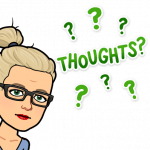 While reading Adner & Kapoor (2016) it occurred to me that, like all change processes, there will be roadblocks. This includes access to technology (either because of infrastructure, financial or intellectual constraints), as well as resistance to change from staff or families who are either change fatigued or stuck in the web1.0 mentalities. Perhaps there are issues around work-life balance, either for adults (addicted to screens and social media or overwhelmed by the need to take work home or have work cross over into the social sphere) or children (similarly addicted to screen time). These will all need to be considered in the 4 phases of creating a group digital presence or organisation’s digital learning environment (discussed at length in previous blog posts).
While reading Adner & Kapoor (2016) it occurred to me that, like all change processes, there will be roadblocks. This includes access to technology (either because of infrastructure, financial or intellectual constraints), as well as resistance to change from staff or families who are either change fatigued or stuck in the web1.0 mentalities. Perhaps there are issues around work-life balance, either for adults (addicted to screens and social media or overwhelmed by the need to take work home or have work cross over into the social sphere) or children (similarly addicted to screen time). These will all need to be considered in the 4 phases of creating a group digital presence or organisation’s digital learning environment (discussed at length in previous blog posts).
There is also the issue of needing to be innovative in the types of platforms that we promote as educators (as supported by the research of Manca (2020). Which brings up another roadblock to implementing social media for schools is the fact that there is an age limit for access – most students in K-6 Australian educational settings are below the age of 13 and cannot be encouraged by educators to look at nor participate in most social media applications. This means we have to tailor our content to an older demographic and seek out other (less public) social media platforms for younger students.
Some additional roadblocks or things to consider have been provided by Business.gov.au (2019) and they are to have a clear social media strategy, be mindful that additional staff or resources may be required for daily monitoring of all online platforms, be prepared for inappropriate behaviour (bullying, harassment, negative feedback, misleading or false claims, copyright infringement, information leaks or hacking) and have an action plan ready within your policy documents detailing specifically how to deal with these instances prior to launch date(s).
Hicks, Cavanagh & VanScoy (2020) recommend monitoring a library’s online presence via a ‘social network analysis (SNA).’ The SNA is a ‘theoretical framework and quantitatively oriented methodology’ for libraries to understand their ‘big data stories’ or connections with their community identifying relevant patterns and relationships among individuals, groups, or organisations over a specified period of time.
All of these issues need to be incorporated into the digital learning environment creation plan, a four phase process that I’ve detailed in a previous blog post from Digital Citizenship, but that can best be summarised in this infographic:
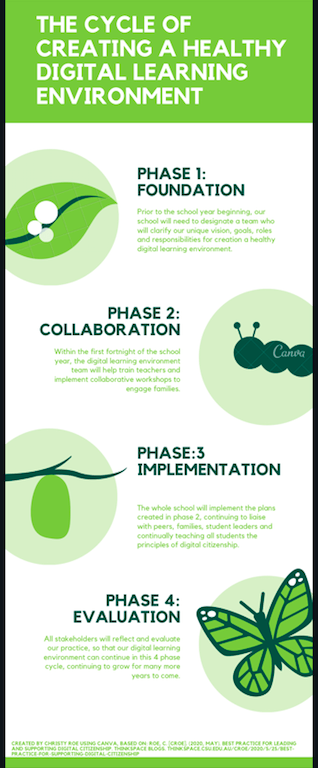
How to design a platform and design it well, improving engagement (web 2.0)
This leads to the next issue – how to have a website (web 1.0), that is interactive (web 2.0) and makes the step towards linking the online world to the offline world (web 3.0). We need to be thinking beyond web 1.0 in terms of having a simple ‘face’ website that offers little to no interaction and does not enable, encourage (nor monitor) engagement but a platform, website and social media presence that actively engages our users. The web 2.0 model of ‘likes’ is also becoming an outdated model and with web 3.0 we must begin to think of our digital presence as fully interactive, including building meaningful ongoing connections (Barnhart, 2020).
But each context must first ask “what does it mean to have ‘engaged users?” and “what platforms / website / social media should we use to engage them?”
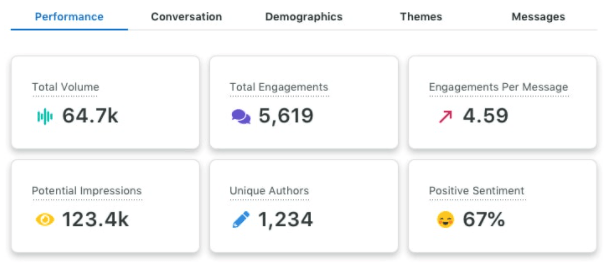
After my practical work-placement in a local public library, where I completed two weeks of ‘virtual’ research on website design (offering several recommendations for website development for the library), I realise that there are almost infinite resources, research and opinions on how to design effective websites. I don’t believe that my understanding of moving from the web presence currently (as web 1.0) to web 2.0 (more interactivity) to even web 3.0 (content creation by the users) was fully developed, until I watched the video provided in module 2 of INF506 (Schwerdtfeger, 2013). I wish I had been able to communicate this idea previously.
Yet, one key article that I did find, in the interest of brevity, was Garett, Chiu, Zhang & Young’s (2016, p.1) literature review on website design in terms of user engagement. Their 4 notable findings were:
- “Websites have become the most important connection to the public and using social media links on websites may increase user engagement;
- Proper website design is critical for user engagement, because poorly designed websites result in a higher user ‘bounce’ rate (users do not proceed past the home page) whereas, well designed websites encourage user exploration and revisit rates;
- The International Standardised Organisation (ISO) (in Garett, et al., 2016, p.1) defines website ‘usability’ as: “the extent to which users can achieve desired tasks (e.g., access desired information or place a purchase) with effectiveness (completeness and accuracy of the task), efficiency (time spent on the task), and satisfaction (user experience) within a system”;
- Out of the 20 identified design elements that impact user engagement, 7 key design elements (in order of importance) are navigation, graphical representation, organisation, content utility, purpose, simplicity and readability.” Garett et al. expand these design element definitions, but the key words are:
-
- Effective navigation: consistent menu/navigation bars, search features, multiple pathways and limited clicks/backtracking.
- Engaging graphical presentation: images, size and resolution, multimedia, font, font colour and size, logos, visual layout, colour schemes, and effective use of white space.
- Optimal organisation: logical, understandable, and hierarchical / architectural structure, arrangement / categorisation, and meaningful labels/headings/titles/keywords.
- Content utility: information is sufficient, of ongoing quality and relevant
- Clear purpose: 1) establishes a unique and visible brand/identity, 2) addresses visitors’ intended purpose and expectations for visiting the site, and 3) provides information about the organisation and/or services.
- Simplicity: clear subject headings, transparency, optimised size, uncluttered, consistent, easy, minimally redundant and understandable.
- Readability: easy, well-written, grammatically correct, understandable, brief, and appropriate.
References
Adner, R., & Kapoor, R. (2016). Right tech, wrong time. Harvard Business Review, 94(11), 60-67.
AlAwadhi, S. (2019). Marketing academic library information services using social media. Library Management, 40(3/4), 228-239. doi:10.1108/LM-12-2017-0132
Arteaga, S. (2012). Self-Directed and transforming outlier classroom teachers as global connectors in experiential learning. (Ph.D.), Walden University. http://search.proquest.com.ezproxy.csu.edu.au/docview/1267825419/BD063751849440E5PQ/1?accountid=10344
Barnhart, B. (2020, January 5). The most important social media trends to know for 2020. [Blog post]. https://sproutsocial.com/insights/social-media-trends/
Business.gov.au (2019). Social media for business. https://www.business.gov.au/Marketing/Online-presence/Social-media-for-business
Garett, R., Chiu, J., Zhang, L., & Young, S. D. (2016). A literature review: website design and user engagement. Online journal of communication and media technologies, 6(3), 1.
Hicks, D., Cavanagh, M. F., & VanScoy, A. (2020). Social network analysis: A methodological approach for understanding public libraries and their communities. Library & Information Science Research, 42(3), 101029. doi: https://doi.org/https://doi.org/10.1016/j.lisr.2020.101029
Jenkins, H., Clinton, K., Purushotma, R., Robison, A. J., & Weigel, M. (2006). Confronting the challenges of participatory culture. https://www.macfound.org/media/article_pdfs/JENKINS_WHITE_PAPER.PDF
Kwon, K. H., Shao, C., & Nah, S. (2020). Localized social media and civic life: Motivations, trust, and civic participation in local community contexts. Journal of Information Technology & Politics, 1-15.
Manca, S. (2020). Snapping, pinning, liking or texting: Investigating social media in higher education beyond Facebook. The Internet and Higher Education, 44, 100707. doi: https://doi.org/https://doi.org/10.1016/j.iheduc.2019.100707
Mon, L. (2014). Social Media and Library Services. Morgan & Claypool Publishers. ProQuest Ebook Central, http://ebookcentral.proquest.com/lib/csuau/detail.action?docID=2010483.
Nisar, T. M., Prabhakar, G., & Strakova, L. (2019). Social media information benefits, knowledge management and smart organizations. Journal of Business Research, 94, 264-272. doi: https://doi.org/10.1016/j.jbusres.2018.05.005
Schwerdtfeger, P. [Patrick Schwerdtfeger] (2013). What is web 2.0? What is social media? What comes next? https://www.youtube.com/watch?v=iStkxcK6_vY
Van Dijck, J. (2018). Introduction. In J. Van Dijck (Ed.), The Platform Society. Retrieved from Oxford Scolarship Online.
Introduction to Social Media – Reflection on INF506 Module 1

OLJ task 1: Social Media and Society – Journal Article Analysis
Self Esteem and Social Media, a Reflection:
I’ve selected the article by Lavrence & Cambre (2020) because it (and a few other of the articles provided) brings up another issue (in addition to those I mentioned in my previous post – not part of this assessment) with social media use: self esteem. The world of online interaction is a reflection of our 3 dimensional ‘real’ world, but it isn’t itself particularly ‘real.’ There has been a lot of research behind the use of magazines and their impact on the self esteems of various people. Men, young men, women, and just people in general. It makes sense therefore for the content to remain influential, despite the mode of delivery changing from printed magazines to electronic forms and social media.
Just as history has been written by the winners and images have been photoshopped and filtered, so too should we expect social media to be rife with filters and propaganda style imagery. To pretend that social media is responsible for the concepts of “raced, gendered, classed, aged, abled” information belies the historical examples of these issues in our society. The only thing that has changed is the mode of delivery and as educators we must help our students be aware of these issues so that they can identify them and discredit or stand up to them where necessary.
I particularly liked the phrase: “(we must) recast validation for appearance as a primary source of female empowerment through ideologies of online visibility” (Lavrence & Cambre, 2020, p.3). In terms of editing ‘selfies,’ I personally find them empowering. I occasionally play with the filters and then take a ‘real’ (unfiltered) photo in order to ground myself. I can generally tell when I need to get more sleep or apply creams to my skin or frizz gel to my hair from these experiences but don’t particularly notice my esteem changing. Nor do I notice my esteem changing when I see digitally enhanced images on the internet. Celeste Barber is a great master at this as well on Instagram – often copying ‘fake’ videos and images with more realistic versions. We still need validation for our appearance, we still need empowerment and we need to recognise different ideologies of online visibility, and we can still do these things with ‘selfies.’
I had not heard of ‘rinsta’ and ‘finsta’ but the concepts are interesting. I like to change photos sometimes because the normal camera filter does not represent the true beauty that I felt in that moment. Sometimes it is a selfie and sometimes it is a sunset. I consider these slightly edited images real, even though I also use the #nofilter on those occasions were the original represented near perfect reality. I think it is important to help our students develop their ‘digital forensic gaze’ (Lavrence & Cambre, 2020, p.11) to help them maintain a more stable self-esteem, particularly those who identify as cis-women, but as we’ve seen in the magazine era, not limited to cis-women.
Introduction to Social Media – Reflection on INF506 Module 1
Is social media good for us, or do we perceive it to be bad based on (possibly) outdated perceptions of healthy interaction?
I’m no stranger to social media. I have accounts on all of the top platforms, although I find Twitter a more boring version of Facebook and rarely check it) and even have my own Facebook group (#teacherswhoknowme). I am, in fact, questioning the benefits given the amount of time I spend on it instead of doing other, more traditionally ‘productive’ activities.
Yet, growing up, I was addicted to reading. I thought nothing of spending entire days in bed reading a stack of books that I checked out from the library, or later in my teens, books I’d bought in used bookstores. I even had a best friend who shared my love of reading and we’d chill in her room for entire weekends reading or going to bookstores and libraries. It seems a weird thing to do now but at the time, it never occurred to us. It probably saved us from the pursuits of boredom that impact teen behaviour today. (e.g. We weren’t hanging out at the shopping mall, smoking cigarettes or creating graffiti, etc).
Furthermore, my brother and I grew up playing outside a lot, as typical in the childhoods of the 1980’s and prior, but I remember when we moved in to live with my dad that my step mother lamented that we spent too much time on the sofa watching TV. What they did not take into account was our ‘social capital’ (Lampe, 2015) had changed. We no longer felt confident to roam outside freely and we preferred to stick together in our new environment. Similarly, the social capital of today’s youth has changed.
Nothing remains static in this world, why should socialising methods? Apart from the need for our society to increase their levels of physical activity to negate the health impacts of a sedentary lifestyle, why shouldn’t we be able to socialise primarily via diverse social media platforms, spending ‘time and effort’ building friendships in this environment, particularly if ‘communication of all forms builds relationships’ (Lampe, 2015).
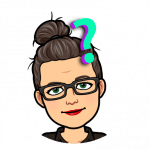 This reminds me of the readings on ‘participatory culture’ / 21st century learning skills.
This reminds me of the readings on ‘participatory culture’ / 21st century learning skills.
Another change to society is that social media allows us to have more ‘weak ties’ (Lampe, 2015) with a larger amount of people, building the amount of information to which we have access makes collaboration easier, and improves access to information for those who may have limited access in their physical environments.
Yes, I probably spend ‘too much’ time on Facebook. And I can definitely say that this is related to the stress I feel on particular days, living in a new house that needs renovating in a new town with my children increasingly occupied in their own pursuits and my husband having to commute and spending more time at work. I need the connection and I need it to be familiar. I just need to remember to have a healthy work – life balance!
 (Note: Some colleagues don’t like to use Facebook / social media for work purposes as it has the potential to cross over their work – life balance)
(Note: Some colleagues don’t like to use Facebook / social media for work purposes as it has the potential to cross over their work – life balance)
Social Media and Education
Akcaoglu & Bowman (2016, 2.1) are spot on when they say that the use of Facebook by educators creates “more interest in and perceive(d) more value in course content, (with students feeling) closer to the course and perceive(d) their instructors as more involved.” [However it is important to note that if I try to utilise Facebook in a primary school setting, it will not be for the use of my students as they are all ‘under age’ by the terms and conditions created by Facebook (and Instagram, etc) and I will therefore have to be creative in enabling global connections for my students.]
Personally, I am glad to not have to use the discussion forums anymore as the students waffle on. With Facebook, we are all used to ‘soundbites’ or snippets of information, scrolling on when we see long posts so I’m hopeful the waffling will be minimal with this course. (Save the waffling for your blog, I say!)
 I am also reminded of the readings from Digital Citizenship, where we need to use 21st Century Learning devices for 21st Century learners…
I am also reminded of the readings from Digital Citizenship, where we need to use 21st Century Learning devices for 21st Century learners…
Social media influence and misinformation
Gruzd, Wellman & Mai (2017) offer important points regarding social media, in terms of its influence and misinformation. Advertising (influence) is difficult to spot – in fact, individual people advertise on social media often just as well as corporations – and do so without cost to themselves. YouTube and Instagram have become renown for their social media ‘influencers’ (people who make a living using their personal social media platforms as advertising on behalf of larger corporations and even governments or those with political agendas). ‘Alternative facts’ or misinformation (lies – as I prefer to call them) are now as rife as hidden advertisements on TV, junk mail in the post and spam emails once were. As educators, we must help our students recognise these traits and use social media responsibly!
Link to Glossary of Social Media Terms
References
Akcaoglu, M., & Bowman, N. D. (2016). Using instructor-led Facebook groups to enhance students’ perceptions of course content. Computers in Human Behavior, 65(C), 582-590. doi: 10.1016/j.chb.2016.05.029
Gruzd, A., Jacobson, J., Wellman, B., & Mai, P. H. (2017). Social media and society: Introduction to the special issue. American Behavioral Scientist, 61(7), 647-652. doi:10.1177/0002764217717567
Lampe, C. [TEDxTalks]. (2015, April 6). Is social media good for you? TEDxUofM. [Video] https://www.youtube.com/watch?v=po01VlNvCcQ
Lavrence, C., & Cambre, C. (2020). “Do I Look Like My Selfie?”: Filters and the Digital-Forensic Gaze. Social Media + Society. https://doi.org/10.1177/2056305120955182
Best practice for leading and supporting digital citizenship
(Reflecting on my learning in ETL523 Modules 4, 5 & 6)
“Digital leaders understand that we must put real-world tools in the hands of students and allow them to create artefacts of learning that demonstrate conceptual mastery. This is an important pedagogical shift as it focuses on enhancing essential skill sets—communication, collaboration, creativity, media literacy, global connectedness, critical thinking, and problem solving – that society demands….Leaders need to be the catalysts for change…..Digital leadership begins with identifying obstacles to change and specific solutions to overcome them in order to transform schools in the digital age” (Sheninger, 2017).
Notably, in terms of creating a productive digital learning environment, Sheninger (2017) identifies ‘7 pillars for digital leadership in education’ as: communication, public relations, branding, student engagement/learning, professional growth/development, re-envisioning learning spaces and environments, and opportunity.
Rather than avoid global connections and social media, and rather than limit our students (forcing them to go ‘underground’ with a secret world of digital environments of their own making) we need need to learn how to embrace it safely and productively as global digital citizens (Ohler, 2011). We also need our school principals and supervisors to help promote a community of practice and positive learning environments by being “willing to listen, delegate, distribute, empower, and step out of the way of the learning” (Lindsay, 2016, p.110).

Utilising the readings for modules 4, 5 and 6, as well as a few of my own, following the 6 month multi-phase structure suggested by Chen & Orth (2013), Cofino (2012) and Common Sense Media (n.d.) which begins prior to the start of the school year, we can complete the following 4 phases:
-
Prior to the school year beginning, school contexts need to begin phase 1 by clarifying our unique vision, goals, roles and responsibilities:
- First. form a strong team of information and digital technology leaders (Chen & Orth, 2013; Common Sense Media, n.d.). (See my previous 9 blog posts on creating a school Community of Practice or the evaluation of practice via the 3 blog posts on Quality Teaching Framework/Rounds and also this video on Teacherpreneurs from the Centre for Teaching Quality for motivation!)
- Create and deliver an environmental scan utilising this template for a ‘Situational Analysis’ by Christy Roe (based on suggestions from) the resources provided by Hague & Payton (2010), and/or Pashiardis (1996), particularly as shown in the hexagon images below:
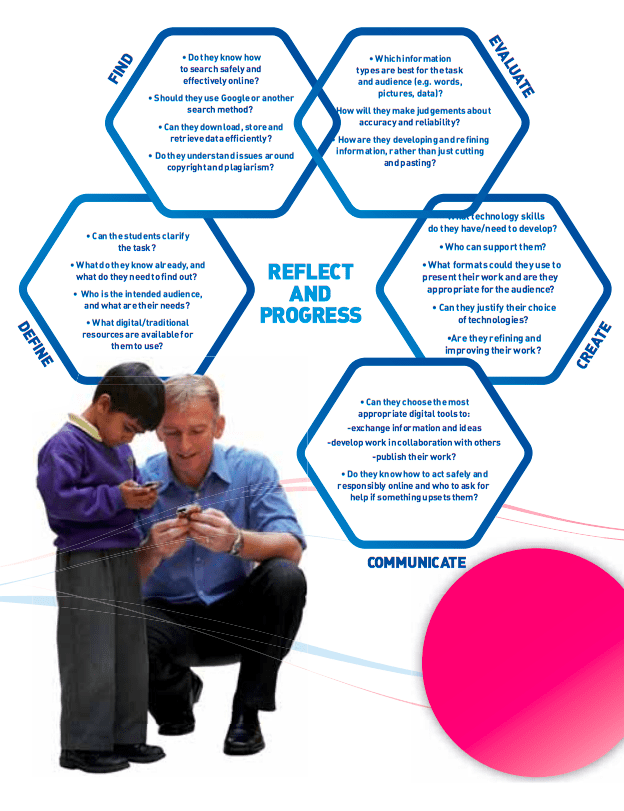
Digital Literacy Planning Tool ‘Reflect & Progress’ image by Hague & Payton, 2010, p.47 - Implement a technology audit (such as this one created by Christy Roe) and/or bullying survey (such as this one created by the University of South Australia) (Chen & Orth, 2013).
- Facilitate the formulation of policies, procedures or guidelines such as an acceptable use policy (using a questionnaire such as this one created by Christy Roe) based on the policy created by the administration (such as those listed in the resources section below), including cohesive terminology that we will utilise as a school (Common Sense Media, n.d.), e.g. linking the Positive Behaviour for Learning Behaviour Matrix or Code of Student Conduct to the school’s “Acceptable use Policy (AUP), Responsible Use Guidelines (RUG), Acceptable Use Agreement (AUA), Internet Use Policy (IUP), Bring Your Own Device (BYOD), or Bring Your Own Technology (BYOT)” etc.
- Liaise with others in our personal learning networks (PLN) (Sheninger, 2017) to map the digital citizenship areas of the syllabus or curriculum documents (NESA / ACARA), find examples of a digital citizenship scope and sequence (such as this (2011) one by Mike Ribble), develop sample lessons or units of work, and accumulate appropriate resources (such as those provided in the resources section below)–made available to all stakeholders (Common Sense Media, n.d.).
- Allow teacher librarians (and the school leadership teams) to readily undertake the role of information leaders who ‘meet the students where they are,’ recognising that there may not only be gaps in terms of technology access, or information access, but there may also be an (intergenerational) gap between what some view as the purpose of technology – i.e. is the purpose of technology to assist in informing, socialising or varying degrees of both, and what is true for the individuals in each school or home context? (Levinson, 2010, p.11).
2. In phase 2, within the first fortnight of the school year, we must train teachers and engage families:
“Alignment between school and home with regards to digital citizenship and healthy digital usage is a hallmark of a 21st-century school. A community-wide understanding of the norms, rules of behaviour, rules of engagement, and common practices is necessary for all schools in order to raise an ethical, digital (and real-life) citizen. Without this key parental partnership, these conversations regarding digital citizenship will just become incoherent whispers in the minds of our students, overwhelmed by the louder voices of media, false information, and misunderstanding” (Chen & Orth, 2013).
- As per the circles image from Hague & Payton (2010) (as well as information from Sheninger (2017)), schools and families need to continually foster 21st century learning and digital literacy skills such as: creativity, (innovation), critical thinking, evaluation (and problem solving), cultural and social understanding, collaboration, effective communication, (global collectedness), the ability to find and select information, (media literacy), e-safety and technological functional skills.
- While at the same time, we must also utilise situations of technology misuse as learning opportunities (see the POISE image below) for the students as well as ourselves as adult digital citizens, setting appropriate boundaries, listening student voices, and continuously encouraging digital literacy and digital citizenship (Chen & Orth, 2013).
- Educators as professionals need to get onboard with 21st century learning and nurture safe, culturally aware, global citizenship and global connections for ourselves as well as for and with our students (Hilt, 2011);
- We must ensure that our digital citizenship curriculum not only protects our students in terms of safety, privacy, copyright, fair use or legality issues, but that it also promotes global cultural, gender, socio-economic status, religion, language and ability awareness and a global appreciation of difference (Hilt, 2011).
- Educators who have embraced the need for global digital citizenship and global connections, need to lead by example and have our own safe, culturally aware, positive and professional ‘brand’ or digital footprint, and we also need to help our students create and tailor their own safe, culturally aware and positive digital footprint ‘brand(s)’ (Neilson, 2012).
- The digital citizenship leadership team, or perhaps even the whole staff, need to hold regular meetings and face to face information and collaboration sessions with families to ensure that preferred means of communication are clarified, that families have input into the digital citizenship program and also so that families are given support in implementing policies, procedures and guidelines at home that suit their individual situation(s) (Chen & Orth, 2013; Levinson, 2010).
- Finally, the digital citizenship team need to develop a plan to help students move from digital citizenship to digital leadership by creating a technology peer mentorship or student technology leadership program (such as YesK12.org) (Oxley, 2012; TeachThought Staff, 2018).
3. In phase 3, we must implement our plans:
- Prior to students being given devices, we must workshop the digital citizenship expectations, policy, procedures and guidelines that we created in phase 1 & 2 (Cofino, 2012).
“The message is threefold: (1) helping children become good digital citizens must be an ongoing practice led by families and schools together; (2) having access to a range of technology and global connections through school creates a positive context in which to have these conversations; and (3) students will make mistakes, and it’s our collective responsibility to turn mistakes into learnable moments” (Chen & Orth, 2013).
-
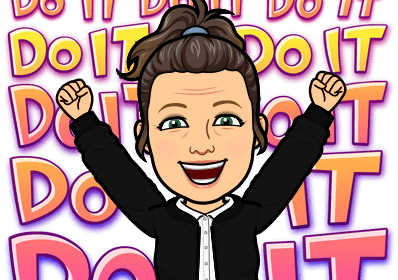
Bitmoji Christy ‘Do it!’ Once students begin to utilise digital devices, we must implement the digital citizenship lessons or units of work that we created in phase 2, with a key focus on 21st century learning skills, boundaries, student voice, digital footprints and global connections.
- We must implement the peer mentorship program that we created in phase 2, including student voice in the consequences for unacceptable behaviours (such as the student court, implied by in the slideshow by Cofino, 2012).
- We must continually check in with families, using the resources and communication devices agreed upon in phase 2.
4. And finally, in phase 4, we will reflect and evaluate:
![Growth Coaching International (n.d.) Growth Framework [Image]](https://thinkspace.csu.edu.au/croe/files/2020/05/Growth-Coaching-International-n.d.-GROWTH-Framework-Image.jpeg)
List of resources for Teachers and Students:
Policies, procedures or guidelines:
- New South Wales Department of Education and Training’s Policies & procedures > Student use of digital devices and online services (implemented January 27, 2020)
- eSafety Commissioner Teacher Resources;
- State of Victoria (Department of Education & Training) – Consent, Acceptable use agreements and Online services (updated November 2018)
- Sample BYOT Policies http://www.teachthought.com/technology/11-sample-education-byot-policies-to-help-you-create-your-own/
- Sample BYOD Policies http://www.k12blueprint.com/byod
- ‘An overview of school AUP’ written by David Warlick (2008)
- New Zealand Ministry of Education – Digital technology: Safe and responsible use in schools (2015). See also Netsafe.
- Code of Conduct (formerly Digital Citizenship Policy) Garibaldi Secondary School (USA).
- Using digital technologies to support learning and teaching – Victorian State Government, Australia
- Edutopia How to create social media guidelines for your school
- Alberta Canada Social Media Policy for School Districts
Resources for digital citizenship lessons:
- In addition to those recommended in my team’s ETL523 Assessment 2 website, there are also:
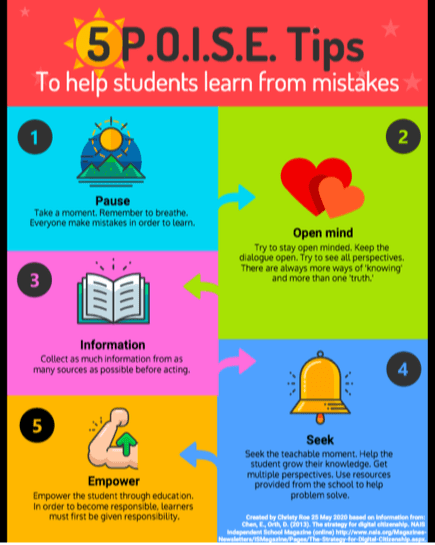
5 POISE Tips Infographic PDF by Christy Roe using information from Chen & Orth (2013) - 5 POISE Tips Infographic (shown here) by Christy Roe, based on information from Chen & Orth (2013) for use by both teachers and families
- Common Craft. (2011). Protecting reputations online. http://www.commoncraft.com/video/protecting-reputations-online.
- Common Sense Media. (2010, November 2). Our Connected Culture. http://youtu.be/L0XQj1anI-E
- eSafety Commissioner Cyberbullying resource
- Digital Life Student Intro Video by Common Sense Media, (2010),
- Overexposed
- Attention young professionals! What’s in your digital baggage?
- DontYouForgetAboutMe. (2007, August 11). Everyone – Think before you post (English). http://youtu.be/4w4_Hrwh2XI.
- ‘I Forgot My Phone’ (YouTube | 2:10 mins) | http://www.youtube.com/watch?v=OINa46HeWg8 CharstarleneTV. (2013, August 22). I forgot my phone. http://www.youtube.com/watch?v=OINa46HeWg8.
Examples of global citizenship programs:
- Global Citizen Diploma program
- Lindsay, J. (2009, March 7). Digiteens go global. http://www.slideshare.net/julielindsay/digiteens-go-global (The Digiteens program is no longer running but information is still available about how to implement it).
- Mirtschin, A. (2012, April 26). Hello little world skypers. http://murcha.wordpress.com/2012/04/26/hello-little-world-skypers-group/
- Morgan, L. (2012, March 19). Skype with an astronaut! http://www.frugalteacher.com/2012/03/skyping-with-astronaut.html
- Internet censorship in China [Tag]. New York Times. https://www.nytimes.com/search?query=internet%20censorship%20in%20china&sort=best
References and further reading
- Beam, C. (2011). Bootleg nation: How strict are Chinese copyright laws? Slate. http://www.slate.com/articles/news_and_politics/explainer/2009/10/bootleg_nation.html.
- Chen, E., Orth, D. (2013). The strategy for digital citizenship. NAIS Independent School Magazine (online) http://www.nais.org/Magazines-Newsletters/ISMagazine/Pages/The-Strategy-for-Digital-Citizenship.aspx.
- Cofino, K. (2012, March 24). Digital citizenship: The forgotten fundamental. http://www.slideshare.net/mscofino/digital-citizenship-the-forgotten-fundamental.
- Common Sense Media (n.d.). Lesson in action: Super digital citizen. http://www.commonsensemedia.org/videos/lesson-in-action-super-digital-citizen
- Growth Coaching International (n.d.) Growth Framework [Image] https://www.growthcoaching.com.au/about/growth-approach?country=au
- Hague, C. and Payton, S. (2010). Digital Literacy Across the Curriculum (Futurelab Handbook). Futurelab. https://www.nfer.ac.uk/publications/FUTL06/FUTL06_home.cfm
- Hilt, L. (2011, October 26). The Case for Cultivating Cultural Awareness. http://plpnetwork.com/2011/10/26/the-case-for-cultivating-cultural-awareness/
- James, C., & Jenkins, H. (2014). Disconnected: Youth, New Media, and the Ethics Gap. MIT Press.
- Levinson, M. (2010). From fear to Facebook: One school’s journey. International Society for Technology in Education.
- Lindsay, J. (2016). The global educator: Leveraging technology for collaborative learning and teaching. International Society for Technology in Education.
- Lindsay. J. (2016, July 19). How to encourage and model global citizenship in the classroom. Education Week http://blogs.edweek.org/edweek/global_learning/2016/07/how_to_encourage_and_model_global_citizenship_in_the_classroom.html
- Lindsay, J. (2014, March 7). Digital citizenship: A global perspective. http://www.slideshare.net/julielindsay/digital-citizenship-a-global-perspective-reduced-size-32020944
- Lindsay, J. (2015, January 8). Leadership for digital citizenship action. http://www.slideshare.net/julielindsay/leadership-for-digital-citizenship-action-acec-2015
- Michaelsen, A. (2013, October 10). Connected educators for connect learners #ce13. http://annmic.wordpress.com/2013/10/10/connected-educators-for-connect-learners-ce13/
- Mirtschin, A. (2012, January 18). Empowering digital citizenship action. http://murcha.wordpress.com/2012/01/18/empower-digital-citizenship-action/
- Mirtschin, A. (2015, November 4). Talk of the school! https://murcha.wordpress.com/2015/11/04/talk-of-the-school/
- Murray, T. (2013, January 7). 10 steps technology directors can take to stay relevant. http://smartblogs.com/education/2013/01/07/the-obsolete-technology-director-murray-thomas/.
- Nielsen, L. (2012, October 29). 4 things you need to know to help your students manage their online reputation by. http://theinnovativeeducator.blogspot.co.uk/2012/10/4-things-you-need-to-know-to-help-your.html.
- Ohler, J. (2011). Character education for the digital age. ASCD Educational Leadership. 68(5). http://www.ascd.org/publications/educational-leadership/feb11/vol68/num05/Character-Education-for-the-Digital-Age.aspx.
- Oxley, K. (2012, August 12). Developing a digital citizenship program. http://www.slideshare.net/cathryno/developing-a-digital-citizenship-program.
- Pashiardis, P. (1996). Environmental scanning in educational organizations: uses, approaches, sources and methodologies. International Journal of Educational Management, 10(3), 5-9.
- Ribble, M.(2011). Digital citizenship in schools. International Society for Technology in Education.
- Sheninger, E. (2017, August 29). 7 pillars of digital leadership in education. https://www.teachthought.com/the-future-of-learning/7-pillars-digital-leadership-education/
- TeachThought Staff (2018, November 18). Moving students from digital citizenship to digital leadership. https://www.teachthought.com/the-future-of-learning/moving-students-from-digital-citizenship-to-digital-leadership/
- Tiven, M. E., Fuchs, E., Bazari, A., & MacQuarrie, A. (2018). Evaluating global digital education: Student outcomes framework. New York, NY: Bloomberg Philanthropies and the Organisation for Economic Co-operation and Development.
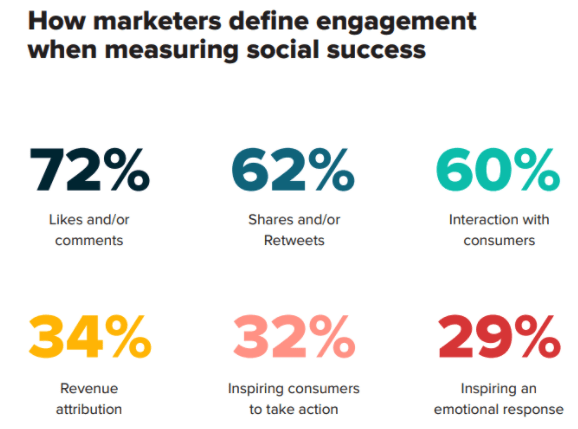
![Hague, C., & Payton, S. (2010). Digital literacy across the curriculum [Handbook [Image]. pp. 19.](https://thinkspace.csu.edu.au/croe/files/2020/05/Hague-C.-Payton-S.-2010.-Digital-literacy-across-the-curriculum-Handbook-Image.-BECTA-FutureLab.-pp.-19.-National-Foundation-for-Educational-Research-httpswww.nfer_.ac_.uk-publicationsFUTL06FUTL06.pdf.png)
